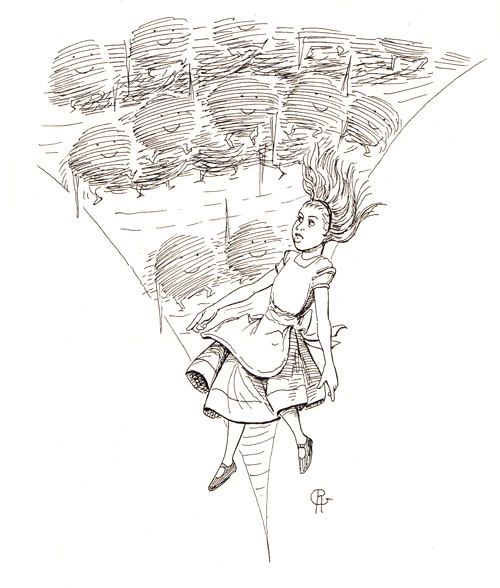I'm mostly asking Descent as our resident future physicist but this really goes out to everyone, have you ever heard of Alice in Quantumland: An Allegory of Quantum Physics? It is, in my opinion, a truly wonderful reimagining of Alice in Wonderland and modern physics written in 1995 by particle physicist Robert Gilmore, who has under his belt experience at Stanford and CERN. I'll just put a few snapshots here.

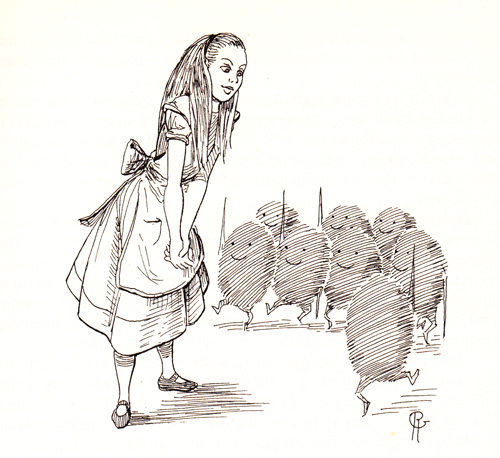
In the first half of the twentieth century, our understanding in the Universe was turned upside down. The old classical theories of physics were replaced by a new way of looking at the world — quantum mechanics. This is in many ways at variance with the ideas of the older Newtonian mechanics; indeed, in many ways it is at variance with our common sense. Nevertheless, the strangest thing about these theories is their extraordinary success in predicting the observed behavior of physical systems. However nonsensical quantum mechanics may at times appear to us, that seems to be the way that Nature wants it — and so we have to play along.
This book is an allegory of quantum physics, in the dictionary sense of “a narrative describing one subject under the guise of another.” The way that things behave in quantum mechanics seems very odd to our normal way of thinking and is made more acceptable when we consider analogies to situations with which we are all familiar, even though the analogies may be inexact. Such analogies can never be very true to reality as quantum processes are really quite different from our normal experience.
[…]
The Quantumland in which Alice travels is rather like a theme park in which Alice is sometimes an observer, while sometimes she behaves as a sort of particle with varying electric charge. This Quantumland shows the essential features of the quantum world: the world that we all inhabit.
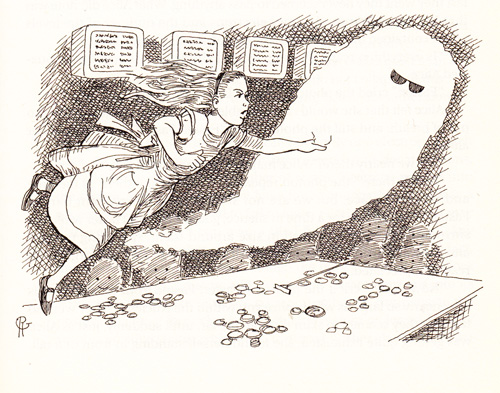
While much of the narrative might appear nonsensical at first sight, “and possibly it may seem so at the second, third, and twenty-fifth sight as well,” Gilmore reminds us that this is the very point of the exercise. He cites godfather of quantum mechanics:
Neils Bohr … is said to have remarked that anyone who did not feel dizzy when thinking about quantum theory had not understood it.<
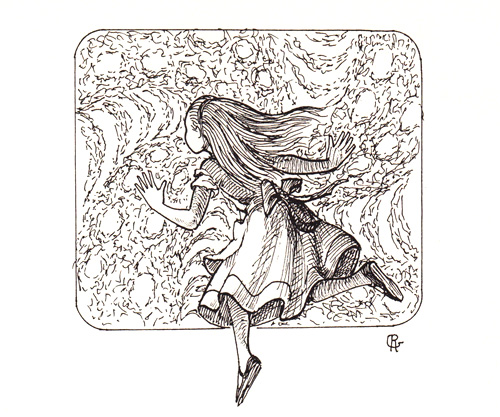
And so, Alice’s journey is off to a properly dizzying start as she falls into a contemporary rabbit hole — the swirling, sparkling TV screen — and ends up in Quantumland. There, we follow her as she visits the Heisenberg Bank and the Mechanics Institute, learning about the curiouser and curiouser behaviors of particles. She marvels at the Uncertain Accountant, whose attempts to balance books are befuddled by energy fluctuations driven by the Heisenberg Uncertainty Principle. The State Agent shows her that, thanks to the Pauli Exclusion Principle, a particle can be two places at once.
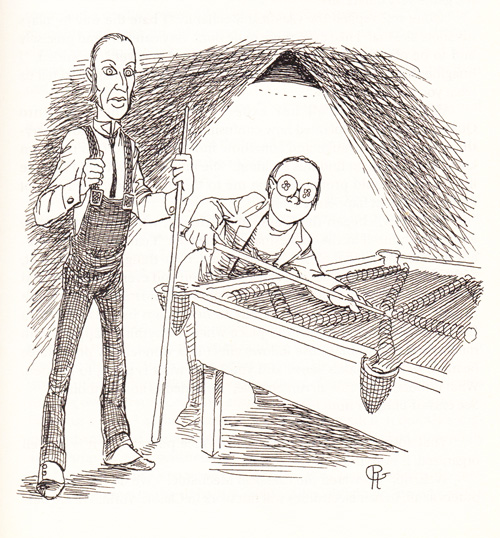
She meets the Classical Mechanic and the Quantum Mechanic, who demonstrate the difference between Newtonian physics and quantum physics in a game of billiards:
“Excuse me, is this the Mechanics Institute, please?” asked Alice, mostly for the sake of making conversation. She knew from the notice outside that it must be.
“Yes, my dear girl,” said the taller and more impressive looking off the two. “I myself am a Classical Mechanic from ClassicWorld, and I am visiting my colleague here, who is a Quantum Mechanic. Whatever your problem is, I am sure that between us we will be able to assist you, if you would just wait a moment while we finish our shots.
Both men turned back to the billiards table. The Classical Mechanic took careful aim, clearly judging all the angles involved to within a tiny fraction of a degree. At last, he very deliberately played his shot. The ball bounced to and fro in a remarkable series of ricochets, ending in a collision with the red ball and knocking it squarely into the center of a hole. “There you are,” he exclaimed with satisfaction as he retrieved the ball from the pocket. “That is the way to do it, you know; careful and exact observation followed by precise action. If you do things that way you can produce any result you choose.
His companion did not respond, but took his place at the table and made a vague stab with his cue. . . . The ball shot off in every direction at once, so that there was no part of the table where [Alice] could say definitely that the ball had not gone, though equally she could in no way say where it actually was. After a moment the player went over and peered into one of the pockets, then reached in and drew out a red ball.
“If you do not mind me saying so,” said Alice, “you do seem to play the game very differently.”
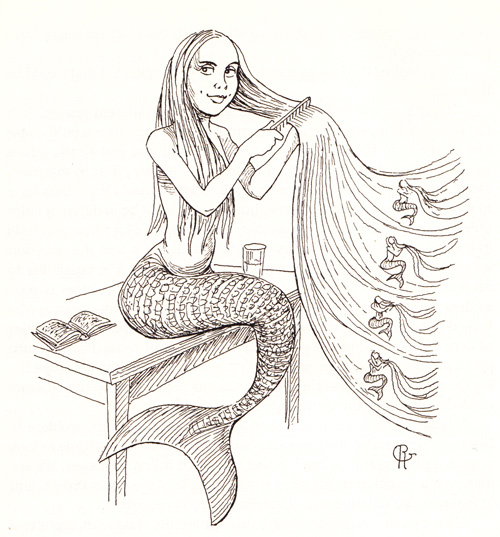
Some adventures later, Alice meets the Little Mermaid, from whom she learns about the theory of many worlds:
“As you know,” she began in a liquid, musical voice, “I am a creature of two worlds. I live in the sea and am equally at home upon the land. But this is as nothing compared with the number of worlds which we all inhabit, for we are all citizens of many worlds — many, many worlds. . . .
The quantum rules … apply to the whole world, to everything. There is no limit to the idea of the superposition of states. When an observer looks at a superposition of quantum states you would expect him or her to see all of the effects that are appropriate to the selection of states present. This is what does happen; one observer does see all the results, or rather the observer also is in a superposition of different states, and each state of the observer has seen the result that goes with one of the states, in the original mixture. Each state is simply extended to include the observer in the act of seeing that particular state.
This is not the way that it seems to us, but that is because the different states of the observer are not aware of one another. When an electron passes through a screen with two slits in it, then it might pass through to the left or to the right. What you observe to happen is pure chance. You might see that the electron has gone to the left, but there will be another you that will have seen the electron go to the right. At the point at which you observe the electron, you split into two versions of yourself, one to see each possible result. If these two versions never get together again, then each remains totally unaware of the other’s existence. The world has split into two worlds with slightly different versions of you in them. . . .”
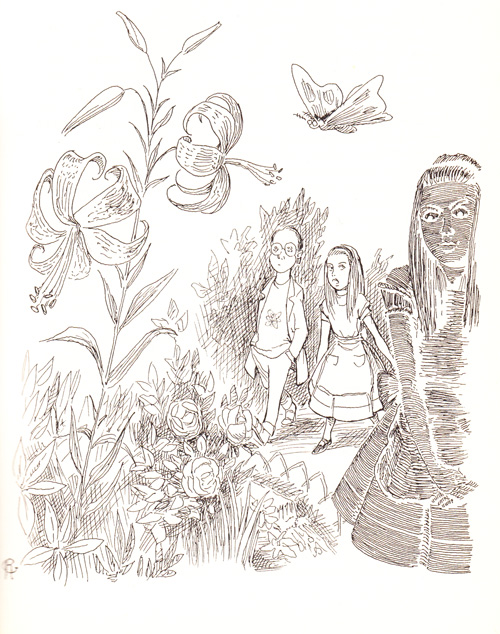
In fact, the most interesting chapter of the book deals with this notion of two versions of oneself, exploring virtual reality as Alice collides with a backwards version of herself, an anti-Alice, while strolling in a beautiful flower garden with the Quantum Mechanic. To understand what made that encounter possible, Alice visits the State Agent, who presents her with an apparatus for seeing the virtual particles of antimatter.
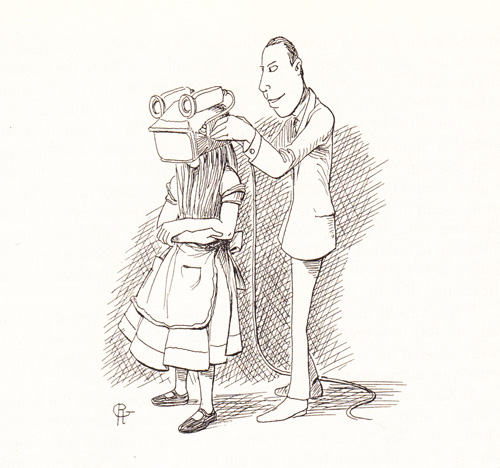
What’s particularly remarkable about this passage is that in addition to serving the allegorical purposes of Gilmore’s quantum story, it also presages with astounding prescience augmented reality tools like Google Glass nearly twenty years before their existence:
[The State Agent brought out] a large and highly technical-looking helmet. This had a transparent visor which entirely covered the front, and there was a long cable attached to a socket at the back. The cable snaked away along the path by which he had come until it was lost from sight in the distance. “Here it is,” he said triumphantly, “a marvel of modern technology. Just put this on, and you will see the world of virtual particles.”
Alice felt a little nervous as she contemplated the helmet. It was large, and it looked very complicated and even, she felt, a little sinister. However, if this was going to reveal the virtual particles she had heard mentioned so often, she was prepared to try it. She put the helmet on her head. It was very heavy. The Agent reached across to the helmet and made some adjustment at the side of her head, where Alice was unable to see. The view through the visor clouded over with little sparkling dots and…
When her view through the visor cleared, it had dramatically changed. Alice could still see the electrons in their various levels, but now instead of their appearing to be within a tall building she saw them as enmeshed in a network of vivid lines which joined one electron to another, so that they looked as much as anything like flies caught in some great spider’s web of shining strands. . . .
Here, Gilmore slips in some equally prescient and rather ominous commentary on the greed that motivates those eager to exploit technological innovation:
As Alice was watching this strange scene with interest, the helmet emitted a whirring noise beside her ear, followed immediately by a loud “clunk.” The view in front of her shimmered and returned to the mundane view she had seen before she put on the helmet. Alice exclaimed aloud in annoyance at losing the fascinating picture. “I am sorry,” said the Agent. “I am afraid that there is a timer built into the mechanism. I had intended to make it coin-operated, you see.”
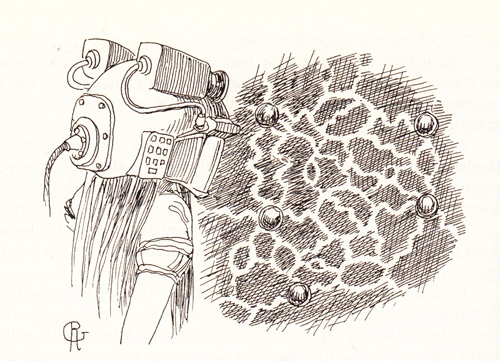
Despite his mercantile motives, the Agent explains to Alice how the photons she just observed through the virtual reality helmet explain her encounter in the garden:
“What happened to you would have appeared to the rest of the world as an unusually high-energy photon giving up its energy to create an Alice and an anti-Alice. The anti-Alice would travel along until it collided with an Alice and the two mutually annihilated one another, converting their energy back to photons.”
“How can that be?” cried Alice in some dismay. “I do not see how this anti-Alice could ever have found a second Alice to collide with anyway. There is only one of me and I certainly haven’t been annihilated,” she concluded defiantly.
“Ah, but what I have just described is how it would appear to the rest of the world. How it would appear to you is quite different, quite different altogether. For you the annihilation would come before the creation of course.”
“I do not see any ‘of course’ about it,” answered Alice rather sharply. “How can anything be destroyed before it is created?”
“Why, that is the natural order of things when you are going backward in time. Normally, when you move forward in time you expect creation to come before destruction don’t you?”
“Yes, of course I do,” replied Alice.
“Well in that case, if you move backward in time you naturally expect the creation to come after destruction from your point of view. You are experiencing events in reverse order after all. I would have expected you to see that for yourself.
“In this case you were walking quietly along with the Quantum Mechanic and suddenly you collided with the anti-Alice. As far as your companion was concerned you and the anti-Alice were both utterly destroyed and your mass energy was carried off by high-energy photons.”
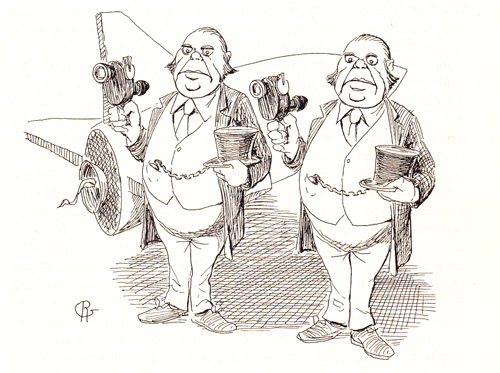
Since the notion of multiple simultaneous states is fundamental to quantum mechanics, it’s a recurring theme in Gilmore’s narrative. Later on, Alice visits the Experimental Physics Phun Phair, where the Great Paradoxus, “a tall figure with glossy black hair, a spiky waxed mustache, and a flowing black cloak,” summons two volunteers for an experiment he is demonstrating. Naturally, those are the twins, the Quantumland counterparts to Lewis Carroll’s Tweedledum and Tweedledee:
Eventually, two people were pushed forward. Both were dressed in long frock coats and narrow trousers, and both had bushy side whiskers. Both wore waistcoats, each with a gold chain attached to a watch which its owner had obviously checked recently against a reliable standard clock. These two were not actually identical to one another, since only particles are completely identical, but they were certainly very much alike. They were obviously both honorable, honest, and reliable as well as being competent and conscientious observers. If they were to say that they had seen something, no one would dream of disputing it.
